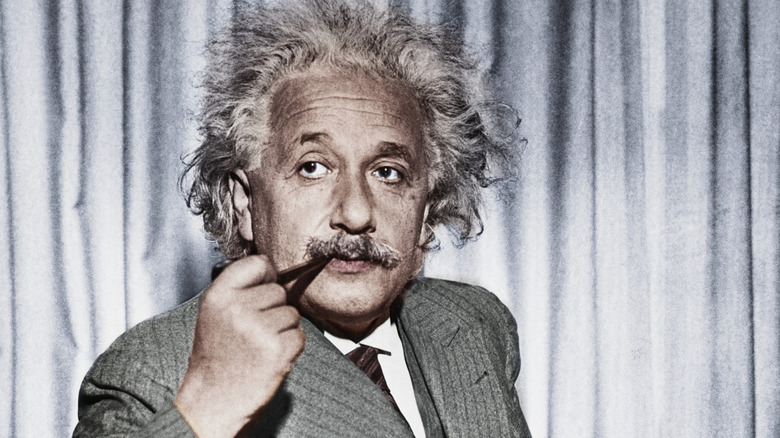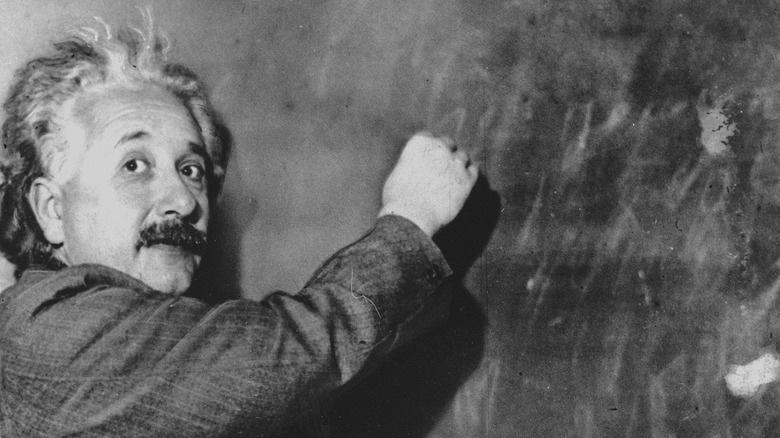The Hard Math Problem That Stumped Einstein
Albert Einstein is widely seen as the greatest mind of the 20th century, but he was still a human being. Indeed, for all Albert Einstein's legendary breakthroughs in physics, he wasn't perfect, and he had his fair share of mistaken beliefs, failures, and blunders. Of course, those shortcomings were often at a more advanced level than those of the average person, but shortcomings they were nonetheless.
According to his own assessment, Einstein's greatest blunder was creating the cosmological constant, a coefficient that he added to his field equations to make them conform with the results of the observations of experimental physics of his time. Without that blunderous multiplier, the math just didn't add up to match his theories with the data. Ironically, his cosmological constant was eventually proven to be a hint at the expansion of the universe, since it implied that the fabric of the cosmos couldn't actually be static. Thus, Einstein's so-called "greatest blunder" was actually not really a blunder at all.
But besides the cosmological constant, there was another math problem that purportedly stumped Einstein, one which was far less consequential for the modern world and more in line with something you might find in a riddle book. It was a simple mathematical prompt sent to him by fellow German refugee Max Wertheimer, a psychologist whose correspondence with Einstein seems to have prodded at the genius' intellect. The superficial simplicity of the problem is what makes it so intriguing. A quick glance at it fails to reveal why Einstein would have struggled to solve it. However, this isn't the kind of math problem you can solve in seconds, and we can pick it apart and see why it may have stumped the father of 20th-century physics, even if he quickly realized its solution — or lack thereof.
The simple problem and its hard solution (or lack thereof)
The math problem given to Albert Einstein by Max Wertheimer that supposedly stumped him is the following (via FS): "An old clattery auto is to drive a stretch of 2 miles, up and down a hill. Because it is so old, it cannot drive the first mile — the ascent — faster than with an average speed of 15 miles per hour. Question: How fast does it have to drive the second mile — on going down, it can, of course, go faster — in order to obtain an average speed (for the whole distance) of 30 miles an hour?"
For anyone who ever attended a high school physics class, the prompt probably seems fairly straightforward to solve. Your first inclination is likely to figure out how much time is required to average 30 mph. We know the total distance is 2 miles and the desired velocity is 30 mph, so if you divide the overall distance by the average speed, you'd get one-fifteenth of an hour (or four minutes). On the surface, the problem seems incredibly basic. The car will need to traverse the 2-mile hill in four minutes to achieve an average speed of 30 miles per hour. So far, so good. So when does it get tricky?
The difficulty in the problem arises as a result of the car's set-in-stone speed of 15 mph while climbing the 1-mile ascent. A car traveling 15 mph takes four minutes to travel 1 mile. And yet, we've already established that it would require 4 minutes to produce an average velocity of 30 mph across the 2 mile distance. Therefore, ultimately, there is no solution. No wonder Einstein was confused.
When a math problem becomes a math riddle
Reportedly, Albert Einstein's initial reaction to the problem was, "Not until calculating did I notice that there is no time left for the way down!" (via FS).
The impossibility of the problem emerges from the automobile's locked-in velocity of 15 mph during its ascent. This ascent takes the full 4 minutes to reach the apex of the hill, and, therefore, there is no possible velocity for the descent that could raise the average velocity to 30 mph. Viewing the problem as a whole, this impossibility becomes obvious. An average velocity is calculated by the total distance traveled divided by the time spent traveling. The problem's "old clattery auto" simply takes too long to ascend the hill to ever hope to achieve an average speed of 30 mph.
Thus, this math problem is more of a riddle, since it doesn't have a feasible solution. Alternatively, if it were to ascend the first mile even 0.0001 mph faster, it could theoretically achieve the desired average speed of 30 mph. That's because 15 mph for the first mile is the slowest velocity for which an overall average velocity of 30 mph becomes impossible. Consider the following hypothetical for an auto traveling just a tiny bit faster. To travel 1 mile at 15.0001 mph, the auto would take 3.9999 minutes. It could then travel the second mile in 0.0001 minutes, at 600,000 mph, to achieve the desired average speed of 30 mph. This insane velocity might seem slow to the physicist who discovered photons, given how fast they move, but it would be fast enough to solve the problem. Unfortunately, the car is stuck going 15 mph on the way up, making the problem impossible to solve.
[Featured image by Los Angeles Times via Wikimedia Commons | Cropped and scaled | CC BY 4.0]


